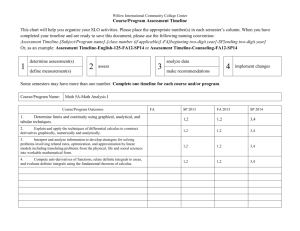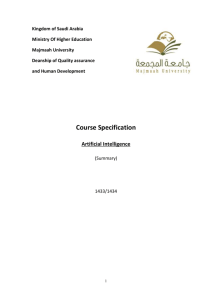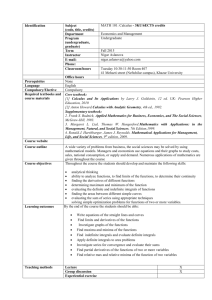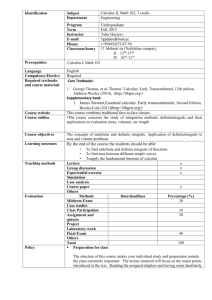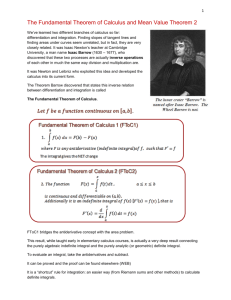AP Calculus AB/BC Standards
advertisement
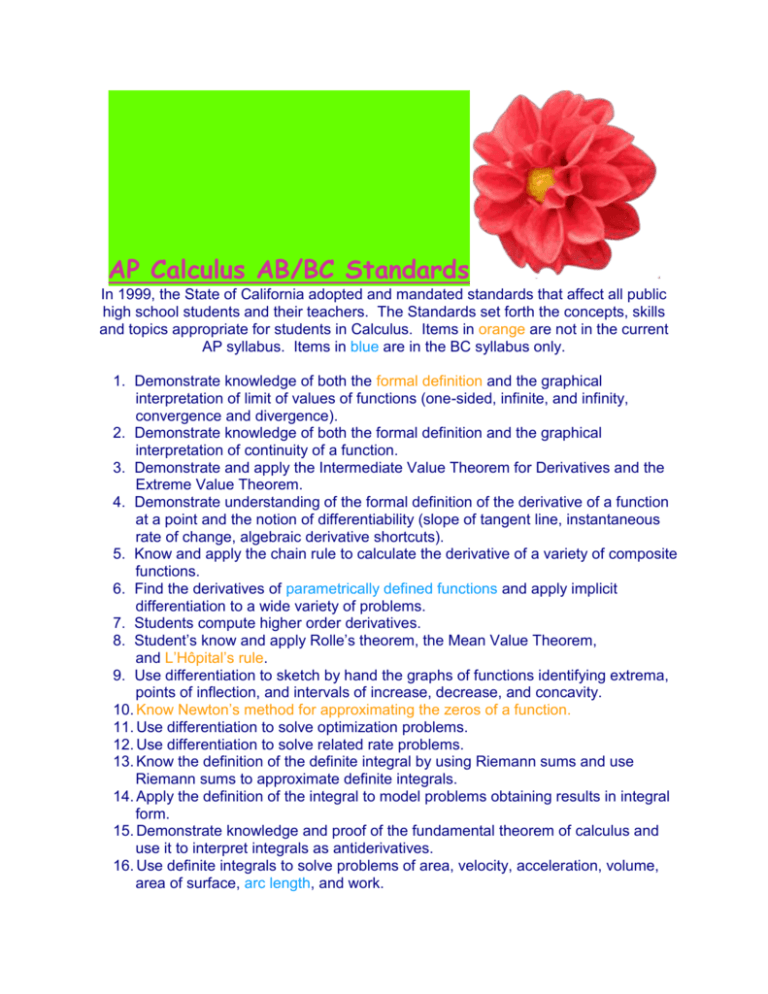
AP Calculus AB/BC Standards In 1999, the State of California adopted and mandated standards that affect all public high school students and their teachers. The Standards set forth the concepts, skills and topics appropriate for students in Calculus. Items in orange are not in the current AP syllabus. Items in blue are in the BC syllabus only. 1. Demonstrate knowledge of both the formal definition and the graphical interpretation of limit of values of functions (one-sided, infinite, and infinity, convergence and divergence). 2. Demonstrate knowledge of both the formal definition and the graphical interpretation of continuity of a function. 3. Demonstrate and apply the Intermediate Value Theorem for Derivatives and the Extreme Value Theorem. 4. Demonstrate understanding of the formal definition of the derivative of a function at a point and the notion of differentiability (slope of tangent line, instantaneous rate of change, algebraic derivative shortcuts). 5. Know and apply the chain rule to calculate the derivative of a variety of composite functions. 6. Find the derivatives of parametrically defined functions and apply implicit differentiation to a wide variety of problems. 7. Students compute higher order derivatives. 8. Student’s know and apply Rolle’s theorem, the Mean Value Theorem, and L’Hôpital’s rule. 9. Use differentiation to sketch by hand the graphs of functions identifying extrema, points of inflection, and intervals of increase, decrease, and concavity. 10. Know Newton’s method for approximating the zeros of a function. 11. Use differentiation to solve optimization problems. 12. Use differentiation to solve related rate problems. 13. Know the definition of the definite integral by using Riemann sums and use Riemann sums to approximate definite integrals. 14. Apply the definition of the integral to model problems obtaining results in integral form. 15. Demonstrate knowledge and proof of the fundamental theorem of calculus and use it to interpret integrals as antiderivatives. 16. Use definite integrals to solve problems of area, velocity, acceleration, volume, area of surface, arc length, and work. 17. Compute by hand integrals of functions using substitution, integration by parts, and trigonometric substitution. 18. Know and use the properties of inverse trigonometric functions for finding indefinite integrals. 19. Compute by hand integrals using the techniques of partial fractions and completing the square. 20. Compute the integrals of trigonometric functions. 21. Understand and apply the algorithms of Simpson’s rule and Newton’s method. 22. Use improper integrals as limits of definite integrals. 23. Demonstrate understanding of the definitions of convergence and divergence of sequences and series of real numbers and apply comparison test, ration test, and alternative series test to determine convergence of a series. 24. Compute the radius (interval) of the convergence of a power series. 25. Differentiate and integrate the terms of a power series in order to form new series from know series. 26. Calculate Taylor polynomials and Taylor series of basic functions. 27. Know how to solve selected elementary differential equations and apply them to a variety of problems. AP Syllabus Items not addressed by the California Standards: 1. 2. 3. 4. The Midpoint Rule as a numerical approximation for a definite integral. Average value of a function (the Mean Value Theorem for Integrals). Slope fields and Euler approximations to the solutions of differential equations. Population models and the Logistic Function. Chick the following file to find the AP Calculus Learning Standards in details. Mathematics Standards of Learning 59 Advanced Placement Calculus This course is intended for students who have a thorough knowledge of analytic geometry and elementary functions in addition to college preparatory algebra, geometry, and trigonometry. The purpose of the course is to prepare students for advanced placement in college calculus. These standards incorporate The College Board Advanced Placement Course Description Syllabus. Teachers should update course content as changes occur in future College Board publications. As mandated by The College Board, graphing calculators are required for this course. Computers should be used when feasible by students and by teachers. Any other available technology tools that will enhance student learning should be used. Instructional activities that engage students in solving application problems of varying complexities are encouraged. APC.1 The student will define and apply the properties of elementary functions, including algebraic, trigonometric, exponential, and composite functions and their inverses, and graph these functions, using a graphing calculator. Properties of functions will include domains, ranges, combinations, odd, even, periodicity, symmetry, asymptotes, zeros, upper and lower bounds, and intervals where the function is increasing or decreasing. APC.2 The student will define and apply the properties of limits of functions. Limits will be evaluated graphically and algebraically. This will include a) limits of a constant; b) limits of a sum, product, and quotient; c) one-sided limits; and d) limits at infinity, infinite limits, and non-existent limits. * *AP Calculus BC will include l’Hopital’s Rule, which will be used to find the limit of functions whose limits yield the indeterminate forms: 0/0 and ∞/∞. APC.3 The student will use limits to define continuity and determine where a function is continuous or discontinuous. This will include a) continuity in terms of limits; b) continuity at a point and over a closed interval; c) application of the Intermediate Value Theorem and the Extreme Value Theorem; and d) geometric understanding and interpretation of continuity and discontinuity. APC.4 The student will investigate asymptotic and unbounded behavior in functions. This will include a) describing and understanding asymptotes in terms of graphical behavior and limits involving infinity; and b) comparing relative magnitudes of functions and their rates of change. APC.5 The student will investigate derivatives presented in graphic, numerical, and analytic contexts and the relationship between continuity and differentiability. The derivative will be defined as the limit of the difference quotient and interpreted as an instantaneous rate of change.Mathematics Standards of Learning 60 APC.6 The student will investigate the derivative at a point on a curve. This will include a) finding the slope of a curve at a point, including points at which the tangent is vertical and points at which there are no tangents; b) using local linear approximation to find the slope of a tangent line to a curve at the point; c) defining instantaneous rate of change as the limit of average rate of change; and d) approximating rate of change from graphs and tables of values. APC.7 The student will analyze the derivative of a function as a function in itself. This will include a) comparing corresponding characteristics of the graphs of f, f ', and f "; b) defining the relationship between the increasing and decreasing behavior of f and the sign of f '; c) translating verbal descriptions into equations involving derivatives and vice versa; d) analyzing the geometric consequences of the Mean Value Theorem; e) defining the relationship between the concavity of f and the sign of f "; and f) identifying points of inflection as places where concavity changes and finding points of inflection. APC.8 The student will apply the derivative to solve problems. This will include a) analysis of curves and the ideas of concavity and monotonicity; b) optimization involving global and local extrema; c) modeling of rates of change and related rates; d) use of implicit differentiation to find the derivative of an inverse function; e) interpretation of the derivative as a rate of change in applied contexts, including velocity, speed, and acceleration; and f) differentiation of nonlogarithmic functions, using the technique of logarithmic differentiation. * * AP Calculus BC will also apply the derivative to solve problems. This will include a) analysis of planar curves given in parametric form, polar form, and vector form, including velocity and acceleration vectors; b) numerical solution of differential equations, using Euler’s method; c) l’Hopital’s Rule to test the convergence of improper integrals and series; and d) geometric interpretation of differential equations via slope fields and the relationship between slope fields and the solution curves for the differential equations. APC.9 The student will apply formulas to find derivatives. This will include a) derivatives of algebraic, trigonometric, exponential, logarithmic, and inverse trigonometric functions; b) derivations of sums, products, quotients, inverses, and composites (chain rule) of elementary functions; c) derivatives of implicitly defined functions; and d) higher order derivatives of algebraic, trigonometric, exponential, and logarithmic, functions. * * AP Calculus BC will also include finding derivatives of parametric, polar, and vector functions.Mathematics Standards of Learning 61 APC.10 The student will use Riemann sums and the Trapezoidal Rule to approximate definite integrals of functions represented algebraically, graphically, and by a table of values and will interpret the definite integral as the accumulated rate of change of a quantity over an interval interpreted as the change of the quantity over the interval b ∫ f '(x) dx = f(b) – f(a). a Riemann sums will use left, right, and midpoint evaluation points over equal subdivisions. APC.11 The student will find antiderivatives directly from derivatives of basic functions and by substitution of variables (including change of limits for definite integrals). * * AP Calculus BC will also include finding antiderivatives by parts and simple partial fractions (nonrepeating linear factors only), and finding improper integrals as limits of definite integrals. * AP Calculus BC will also solve logistic differential equations and use them in modeling. APC.12 The student will identify the properties of the definite integral. This will include additivity and linearity, the definite integral as an area, and the definite integral as a limit of a sum as well as the fundamental theorem: x d/dx ∫ f(t) d(t) = f(x). a APC.13 The student will use the Fundamental Theorem of Calculus to evaluate definite integrals, represent a particular antiderivative, and facilitate the analytical and graphical analysis of functions so defined. APC.14 The student will find specific antiderivatives, using initial conditions (including applications to motion along a line). Separable differential equations will be solved and used in modeling (in particular, the equation y' = ky and exponential growth). APC.15 The student will use integration techniques and appropriate integrals to model physical, biological, and economic situations. The emphasis will be on using the integral of a rate of change to give accumulated change or on using the method of setting up an approximating Riemann sum and representing its limit as a definite integral. Specific applications will include a) the area of a region; b) the volume of a solid with known cross-section; c) the average value of a function; and d) the distance traveled by a particle along a line. * * AP Calculus BC will include finding the area of a region (including a region bounded by polar curves) and finding the length of a curve (including a curve given in parametric form).Mathematics Standards of Learning 62 APC.16 The student will define a series and test for convergence of a series in terms of the limit of the sequence of partial sums. This will include a) geometric series with applications; b) harmonic series; c) alternating series with error bound; d) terms of series as areas of rectangles and their relationship to improper integrals, including the integral test and its use in testing the convergence of p-series; and e) ratio test for convergence and divergence. * * For those students who are enrolled in AP Calculus BC. APC.17 The student will define, restate, and apply Taylor series. This will include a) Taylor polynomial approximations with graphical demonstration of convergence; b) Maclaurin series and the general Taylor series centered at x = a; c) Maclaurin series for the functions ex , sin x, cos x, and 1/(1 – x); d) formal manipulation of Taylor series and shortcuts to computing Taylor series, including substitution, differentiation, antidifferentiation, and the formation of new series from known series; e) functions defined by power series; f) radius and interval of convergence of power series; and g) Lagrange error bound of a Taylor polynomial. * * For those students who are enrolled in AP Calculus BC.



